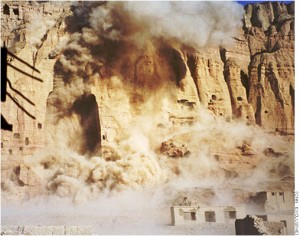Lt. James Granger: “You want to go into a war zone with some architects and artists and tell our boys what they can and cannot blow up.”
Lt. Frank Stokes: “That’s right.”
-Matt Damon to George Clooney, “Monument’s Men” (2014)
What is it like to be told what you can and cannot destroy in the heat of battle? If you are a soldier fighting for your life, chances are that the little voice in your head will probably not be saying, “Don’t destroy that because it is important to the people who live here.”
However, for those indigenous peoples, the items or places which those warring forces are taking and/or obliterating are the sources of their identities. To take and destroy something of that great importance to a particular group of people is the equal to committing genocide, attempting to wipe the traces of those individuals off of the face of the earth. As a former history teacher of mine once said, “To destroy one’s identity is to break one’s spirit. Exterminating any remaining traces of that person or group’s history is a monster’s victory.”

This is where UNESCO has been attempting to intervene and protect the places and objects symbolically linked to cultures across the world. In 1954, the Hague Convention for the Protection of Cultural Property in the Event of Armed Conflict was convened and today has been signed by more than 100 State parties with a majority of its signatories adopting the First (1954) and Second (1999) Protocols of the Convention.
Still, what is there to say about those who have not signed or agreed to the convention’s protocols? After all, those not involved are not bound by those same rules, resulting in ferocious and monstrous offensives designed to demoralize or dehumanize some group of people. For example, the 2001 destruction of the Buddhas in the Bamiyan Provence of Afghanistan by the Taliban struck a devastating blow against the local community. The idols were there ever since the Fourth Century A.D. and now there is nothing left but the hollowed-out caverns where the statues used to stand.

It is these types of attacks which strike at the very core of the intended targets, not to mention the shock felt all across the world in response. However, coming back around to the beginning of this article, if you were a soldier in a situation where your life depended on the destruction of a piece of someone’s identity, what would you do?
This is a call for the reevaluation of rules and precedents like the Hague Convention. How can some be restricted to protect precious cultural properties while others have unrestricted power to destroy such properties? Repatriation is a whole lot more than just giving back what has been wrongly taken as it now has been stretched to involve how to protect what is still left standing. And, hopefully, new protection rules can help prevent future cultural extinctions in the human race.
Bibliography and Further Reading Links
http://portal.unesco.org/en/ev.php-URL_ID=13637&URL_DO=DO_TOPIC&URL_SECTION=201.html
http://www.archaeological.org/news/hca/3137
http://usatoday30.usatoday.com/news/science/archaeology/2001-03-22-afghan-buddhas.htm
Picture 1:
Picture 2: http://upload.wikimedia.org/wikipedia/en/f/fd/Destruction_of_Buddhas_March_21_2001.jpg
